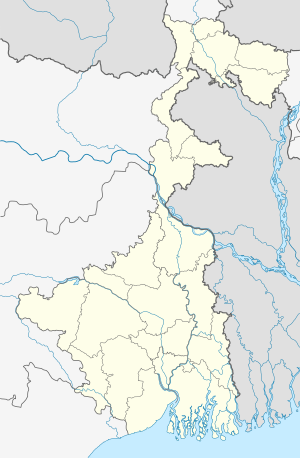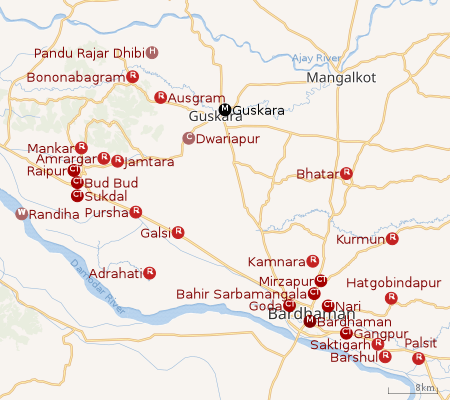Guskara
Guskara is a city and a municipality under Ausgram police station in Bardhaman Sadar North subdivision of Purba Bardhaman district in the Indian state of West Bengal.
Guskara | |
|---|---|
Town | |
Traditional arrangement for stocking rice | |
 Guskara Location in West Bengal, India  Guskara Guskara (India) | |
| Coordinates: 23.50°N 87.75°E | |
| Country | |
| State | West Bengal |
| District | Purba Bardhaman |
| Government | |
| • Type | Municipality |
| • Body | All India Trinamool Congress |
| Area | |
| • Total | 21.15 km2 (8.17 sq mi) |
| Elevation | 38 m (125 ft) |
| Population (2011) | |
| • Total | 35,888 |
| • Density | 1,700/km2 (4,400/sq mi) |
| Languages | |
| • Official | Bengali, English |
| Time zone | UTC+5:30 (IST) |
| Vehicle registration | WB42A0000 |
| Lok Sabha constituency | Bolpur |
| Vidhan Sabha constituency | Ausgram |
| Website | purbabardhaman |
History

The area between the Damodar and Ajay was known as Gopbhum, where the Sadgope kings ruled for many centuries, prior to the advent of the Muslims. The Sur kings also occupy a somewhat mythical position in the region. Adi Sur of this dynasty is credited with having brought the five Brahmins and Kayasthas (two important upper castes in Bengal) from Kannauj in what is now Uttar Pradesh.[1]
Damage to embankments of the Ajay and consequent flooding was a regular problem in the Ausgram and Mangalkot area. The devastating flood of 1943 caused immense suffering and lead to a mass movement for restoration/ repair of the embankments. A massive meeting was organised at Guskara in 1944, with Udaychand Mahtab, Maharaja of Bardhaman. However, the government did not take any action. Ultimately, the Communist Party, which had been at the forefront of agitations for some years, provided a huge work force for the purpose and completed the repair work. That laid the foundation for the party’s popularity in the area.[2]
Geography
 |
| Cities and towns in the Bardhaman Sadar North subdivision of Purba Bardhaman district M: municipal city/ town, CT: census town, R: rural/ urban centre, H: historical site, W: river project, C: craft centre Owing to space constraints in the small map, the actual locations in a larger map may vary slightly |
Location
Guskara is located at 23.50°N 87.75°E. It has an average elevation of 38 metres (125 feet). Guskara is located in the alluvial flood plains of several rivers.[3] Kunur River flows past it.[4]
Urbanisation
73.58% of the population of Bardhaman Sadar North subdivision lives in the rural areas. Only 26.42% of the population lives in the urban areas, and that is the highest proportion of urban population amongst the four subdivisions in Purba Bardhaman district.[5]The map alongside presents some of the notable locations in the subdivision. All places marked in the map are linked in the larger full screen map.
Guskara Airfield
Guskara Airfield is a former wartime United States Army Air Forces airfield in India used during the Burma Campaign 1944-1945. Guskara was a photo-recon base for the Tenth Air Force. Several aircraft including Northrop P-61 Black Widow and Lockheed P-38 Lightning operated from this airfield. It is now abandoned.
Economy
Guskara has a wholesale market.[6] The area thrives on brick kilns, wood craft and cloth sales.[7] This area depends on agro-based economy. Potato,Paddy,Arum are the main agricultural produce of the area. Arum of this area is famous in its taste. Huge amount of potato and paddy is produced in this area. Farmers of the area cannot prosper as they cannot hold on to their produce for long due to want of cash to run family and repay loans. Middlemen earn the profits. Fishery is the other thriving factor of the economy. Fish cultivation and breeding is gaining popularity here. Poultry farms are becoming another factor in the growing economy of this area.
Demographics
As per the 2011 Census of India Guskara had a total population of 35,888, of which 18,573 (51%) were males and 17,315 (49%) were females. Population below 6 years was 3,544. The total number of literates in Guskara was 25,525 (72.13% of the population over 6 years). [8]
As of 2001 India census,[9] Guskara had a population of 31,863. Males constitute 52% of the population and females 48%. Guskara has an average literacy rate of 66%, higher than the national average of 59.5%: male literacy is 72%, and female literacy is 59%. In Guskara, 12% of the population is under 6 years of age.
Steady flow of refugees from East Pakistan swelled the population of the area in the fifties.[10] Recently, an influx of people from outskirt villages has increased the population of the area. Increasing number of buildings, lack of drainage system, absence of complete master plan have made the area a mock of a municipality.
Education
Guskara has sixteen primary, one upper primary, one secondary and three higher secondary schools. It also has one college.
Gushkara Mahavidyalaya was established at Guskara in 1955. It offers honours courses in Bengali, Sanskrit, English, history, geography, political science, philosophy, physics, chemistry, mathematics, botany, zoology, nutrition and B.Com.[11]
Guskara Purnananda Public Institution, a coeducational institution, is affiliated with West Bengal Council of Higher Secondary Education.[12]The school has got a very good academic record. It got President's Medal during the decade of 1950's and was received by former Head Master of the school Nirod Boron Mahata.
Sushila Jangeswar Public High School, a coeducational institution, is affiliated with West Bengal Council of Higher Secondary Education.[13]
Guskara Balika Vidyalaya is affiliated with West Bengal Council of Higher Secondary Education.[14]
A private polytechnic college was established in 2010 "Gobindapur Sephali Memorial Polytechnic" which is recognised by West Bengal state council of technical education.
Art
The area is renowned for its dhokra art castings.[15] In particular, Dariapur village in the area is famous for its dhokra metal craft. The craftsmen and craftswomen are very poor. Middlemen buys dokra artifacts from them and sell them in markets. The middlemen earn the profit. The poor craftsmen and women cannot gain much from their produce as they cannot reach prospective markets to sell their products themselves. Moreover,the craftsmen and women usually take loans from the nearby grocery shops for their daily needs of sustenance. The grocery or shop owners takes artifacts from the craftsmen and women as mortgage for loans. The craftsmen and women are unable to repay the loan. So,the mortgage items become the items of sale in the grocery or shop owners. The last but not the least of the problem that has beset the craftsmen and women is the lack of health and sanitary consciousness.
Transport
There are many totos(e-rickshaw) which are plying here & there.It is a good communication medium of going anywhere at the town.Without it there are Taxis(beside the station) for going far distance.
Train
Guskara (station code-GKH) is well connected with Bardhaman, Howrah and Sealdaha station on down line & Bolpur, Rampurhat, Malda Town & New Jalpaiguri on up line by train. 20 pairs of train run through Guskara railway station everyday. It is a part of Eastern Railway.
Road
Here National Highway named NH114(previously named as NH2B)is gone through which the road connects Bardhaman & Kolkata on south,Bolpur & Rampurhat on north. Another State Highway named SH14 is also going through Guskara which connects Mankar & Durgapur on west,Balgona & Katwa on east.
Bus
One bus-depot is here. Many buses of different routes are gone from here. The common routes are Guskara-Bardhaman (via Galsi & via orgram both),Guskara-Durgapur,Guskara-Katwa(via Balgona mainly & via Natun hat) & Guskara-Bolpur.
References
- Chattopadhyay, Akkori, pp. 150-151
- Chattopadhyay, Akkori, p. 482
- Chattopadhyay, Akkori, Bardhaman Jelar Itihas O Lok Sanskriti (History and Folk lore of Bardhaman District.), (in Bengali), Vol I, p18, Radical Impression. ISBN 81-85459-36-3
- Chattopadhyay, Akkori, p. 35
- "District Statistical Handbook 2014 Bardhaman". Table 2.2. Department of Statistics and Programme Implementation, Government of West Bengal. Retrieved 25 January 2019.
- Chattopadhyay, Akkori, p673
- Chattopadhyay, Akkori, pp. 664-666
- "2011 Census - Primary Census Abstract Data Tables". West Bengal – District-wise. Registrar General and Census Commissioner, India. Retrieved 10 March 2017.
- "Census of India 2001: Data from the 2001 Census, including cities, villages and towns (Provisional)". Census Commission of India. Archived from the original on 16 June 2004. Retrieved 1 November 2008.
- Chattopadhyay, Akkori, p. 57
- "Gushkara Mahavidyalaya". GM. Retrieved 2 March 2017.
- "West Bengal Council of Higher Secondary Education". Budwan. WBCHSE. Retrieved 29 January 2019.
- "West Bengal Council of Higher Secondary Education". Budwan. WBCHSE. Retrieved 29 January 2019.
- "West Bengal Council of Higher Secondary Education". Budwan. WBCHSE. Retrieved 29 January 2019.
- Dokra Art Archived 2009-01-30 at the Wayback Machine
| Wikimedia Commons has media related to Guskara. |